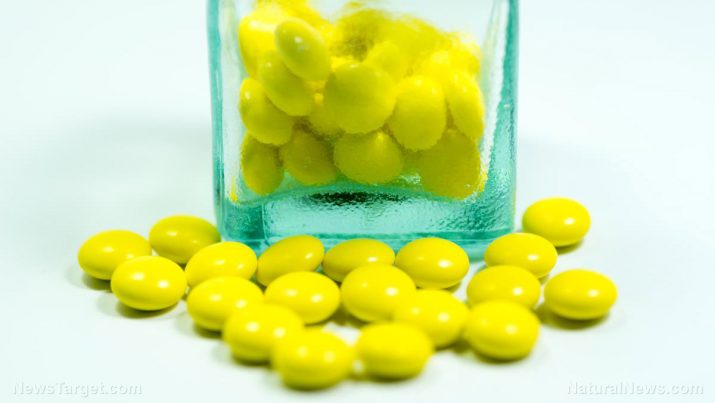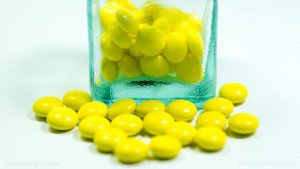
Quinoline Yellow — toxicity, side effects, diseases and environmental impacts
Thursday, November 16, 2017 by Zoey Sky
http://www.naturalpedia.com/quinoline-yellow-toxicity-side-effects-diseases-and-environmental-impacts.html

Quinoline Yellow is the disodium salt of disulphonic acid and it is a synthetic “coal tar” dye. Quinoline Yellow’s color can vary from a dull yellow to a greenish-yellow. The coloring agent is found in ices, scotch eggs, and smoked haddock.
Quinoline Yellow is also known as Quinophthalone, Solvent yellow 33, 11641 Yellow, Erio Chinoline Yellow 4G, Quinoline Yellow 2SF, D & C Yellow no. 11, and D&C Yellow 11.
This coloring agent is often used in lipsticks, hair products, and colognes. Quinoline Yellow is also used in various medications. Although it is a commonly used color in the U.K., the use of Quinoline Yellow is banned in Australia, Japan, Norway, and the United States.

List of known side effects of Quinoline Yellow
In human exposure studies with Quinoline Yellow, investigators observed contact dermatitis due to Quinoline Yellow in 11 out of 149 volunteers who developed a sensitization reaction when tested with the coloring agent with concentrations of 16.4 parts per million (ppm) in a modified Draize test. Allergic reactions to Quinoline Yellow include asthma, hives, and skin rash.
Following several studies on children and hyperactivity, the European Union requires food with Quinoline Yellow to have a label which states: “may have an adverse effect on activity in children.” In December 2008, the European Union took action to require special labeling on foods containing any of 6 different artificial food colorings, which include Quinoline Yellow. The mandate went into effect on July 20, 2010.
Body systems affected by Quinoline Yellow
Upon skin or eye contact, Quinoline Yellow can irritate the integumentary system (skin corrosion or irritation). It can also cause eye damage or irritation. Quinoline Yellow may accentuate any pre-existing dermatitis condition, and open cuts, abraded, or irritated skin should not be exposed to this material. If the coloring agent enters the blood-stream, e.g. through cuts, abrasions or lesions, this may produce systemic injury with harmful effects. Examine the skin prior to the use of Quinoline Yellow to ensure that any external damage is suitably protected.
The coloring agent can also cause respiratory irritation when ingested or inhaled. The body’s response to irritation can cause further lung damage. Individuals with impaired respiratory function, airway diseases, and conditions such as emphysema or chronic bronchitis, may incur further disability if excessive concentrations of Quinoline Yellow are inhaled.
Data about Quinoline Yellow’s carcinogenic effects are not available. However, the coloring agent is mutagenic to mammalian somatic cells, bacteria, and yeast. Quinoline Yellow is classified as a possible toxin for the male reproductive. The substance may be toxic to the kidneys and liver. Repeated or prolonged exposure to Quinoline Yellow can damage the organs or systems affected.
Items that can contain Quinoline Yellow
Aside from lipsticks, hair products, colognes, and various medications, Quinoline Yellow is also used in candy and snack foods. It can also be found in beverages like soft drinks and sports drinks.
How to avoid Quinoline Yellow
To avoid Quinoline Yellow, make your own lemon and lime juices for lemonade and limeade, margaritas, and other mixed drinks. You can make fresher, more flavorful juice using a citrus extractor to avoid any health problems from citrus juice drinks that may contain Quinoline Yellow.
Where to learn more Quinoline Yellow
- Candy bars recalled after tests reveal lead contamination
- The Ongoing Food Coloring Controversy in the UK
- Six artificial colors have been linked to hyperactivity in children, and three of them are still legal in the United States
- Chemical Additives – Are They Slowly Killing Our Children?
- Chemical Additives and Their Effects on Children
Summary
Quinoline Yellow is the disodium salt of disulphonic acid.
The coloring agent can irritate the skin, eyes, and the respiratory system.
Quinoline Yellow can be found in lipsticks, hair products, colognes, and various medications. It is also used in candy, snack food, and beverages.
Sources include:
Tagged Under: Tags: Quinoline Yellow





